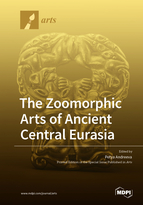The Zoomorphic Arts of Ancient Central Eurasia
A special issue of Arts (ISSN 2076-0752).
Deadline for manuscript submissions: closed (30 December 2022) | Viewed by 19265
Special Issue Editor
Interests: early and medieval Chinese art; Central Asian archaeology; arts of the silk roads; nomadic cultures; jewelry and portable ornament; modern and contemporary art in Central Asia
Special Issue Information
Dear Colleagues,
Following the recent environmental turn in the humanities, a growing corpus of art historical scholarship is responding to the need for post-humanist frameworks in studying the arts of ancient societies. Such works place non-human agents such as fauna in the limelight of their inquiries and, in so doing, shift their focus away from the human practitioner. This line of inquiry is especially pertinent to the study of early China (namely, its northern periphery) and the Iron Age Eurasian Steppe, inhabited mainly by pastoral nomads. Despite having distinctly different preferences for materials and modes of making, both China and the Steppe exhibit a shared aesthetic penchant for zoomorphism. Indeed, animal-inspired bodies define the art and design of these cultural spheres in ways that one would not observe elsewhere in the ancient world. This Special Issue seeks to uncover the different strategies behind the construction and circulation of animal imagery and objects in ancient Central Eurasia (700 BCE–400 CE). Authors may also engage with the usage of products and materials derived from animals, the entanglement of human makers and their biota, animals as cultural capital and tokens of clout, and, more broadly, the role of animals in one’s creative process. The goal of this Special Issue is twofold. It ventures to find new perspectives on ancient cultural spheres that have, for too long, remained on the peripheries of the art historical canon, and whose epistemological potential has not been fully explored. This Special Issue also aims to examine the visual parameters of the unique interactions between pastoralists and the animal kingdom, in light of the former’s great dependency on the latter. Many of the papers in this Special Issue will study the visual and material manifestations of one’s symbiotic or antagonistic relationship with fauna. While primarily focused on nomadic or semi-nomadic peoples, this Special Issue also considers zoomorphism across north China and elsewhere in Central Eurasia and explores the convergent, fluid notions of zoomorphism across these interconnected cultural zones. Contributions that transcend disciplinary boundaries are most welcome.
Dr. Petya Andreeva
Guest Editor
Manuscript Submission Information
Manuscripts should be submitted online at www.mdpi.com by registering and logging in to this website. Once you are registered, click here to go to the submission form. Manuscripts can be submitted until the deadline. All submissions that pass pre-check are peer-reviewed. Accepted papers will be published continuously in the journal (as soon as accepted) and will be listed together on the special issue website. Research articles, review articles as well as short communications are invited. For planned papers, a title and short abstract (about 100 words) can be sent to the Editorial Office for announcement on this website.
Submitted manuscripts should not have been published previously, nor be under consideration for publication elsewhere (except conference proceedings papers). All manuscripts are thoroughly refereed through a double-blind peer-review process. A guide for authors and other relevant information for submission of manuscripts is available on the Instructions for Authors page. Arts is an international peer-reviewed open access semimonthly journal published by MDPI.
Please visit the Instructions for Authors page before submitting a manuscript. The Article Processing Charge (APC) for publication in this open access journal is 1400 CHF (Swiss Francs). Submitted papers should be well formatted and use good English. Authors may use MDPI's English editing service prior to publication or during author revisions.
Keywords
- Eurasian nomads
- ancient China
- Central Eurasia
- animals
- zoomorphism
- funerary art
- material culture
- ancient world





